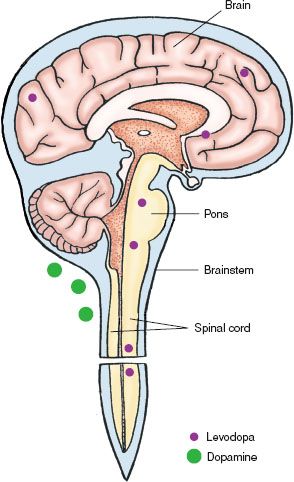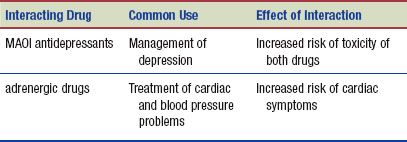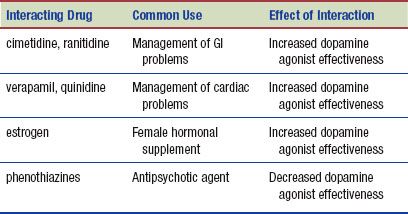DRUG CLASSES
Dopaminergic agents
Monoamine oxidase inhibitors (MAOIs)
Dopamine receptor agonists
COMT (catechol-O-methyltransferase) inhibitors
Cholinergic blocking agents (anticholinergic drugs)
PHARMACOLOGY IN PRACTICE

A woman in the clinic waiting room comes to the front desk and says, “That lady over there is odd. She looks like she is keeping tune to a song with her hand and her head, but there is no music playing. I don’t feel comfortable sitting here in the waiting area.” The patient is Betty Peterson, and she been taking amitriptyline for depression.
The drugs featured in this chapter are used to treat both disease and adverse reactions of other medications. Parkinsonism is a general term that refers to a group of symptoms involving motor movement. The name comes from Parkinson’s disease, a progressive neurologic disease with symptoms that worsen over time. The cardinal signs of Parkinson’s disease include tremors, rigidity, and slow movement (bradykinesia).
Other symptoms of Parkinson’s disease include slurred speech, the face taking on a mask-like and emotionless appearance, and the patient possibly having difficulty chewing and swallowing. The patient assumes a rigid, bent-forward posture and the gait becomes unsteady and shuffled. All these Parkinson-like symptoms may be seen with the use of certain drugs, head injuries, and encephalitis. These movements are also termed extrapyramidal symptoms (EPS).
Drugs used to treat parkinsonism (or more frequently called Parkinson-like symptoms) are called antiparkinson drugs. These drugs either supplement the dopamine in the brain or block excess acetylcholine (ACh) so that better transmission of nerve impulses occurs. The Summary Drug Table: Antiparkinson Drugs provides a listing of the drugs used to treat Parkinson’s disease and EPSs.
DOPAMINERGIC DRUGS
Dopaminergics are drugs that affect the dopamine content of the brain. These drugs include levodopa, carbidopa (Lodosyn), amantadine, and carbidopa/levodopa combination (Sinemet). Other drugs that work to enhance dopamine include agonists such as bromocriptine (Parlodel) or monoamine oxidase inhibitors (MAOIs) such as selegiline (Eldepryl) (see Summary Drug Table: Antiparkinson Drugs).
Actions
The Parkinson-like symptoms are caused by a depletion of dopamine in the central nervous system (CNS). Supplementing dopamine is difficult due to a structure called the blood–brain barrier. The blood–brain barrier is a meshwork of tightly packed cells in the walls of the brain’s capillaries that work to protect the brain by screening out certain substances. This unique meshwork of cells in the CNS prohibits large and potentially harmful molecules from leaving the blood and crossing into the brain. This ability to screen out certain substances has important implications for drug therapy, because different drugs can pass through the blood–brain barrier more easily than others. Therefore, dopamine is not easy to supplement because it is one that does not easily cross the blood–brain barrier.
Levodopa is a chemical formulation found in plants and animals and is converted into dopamine by the body. Dopamine, in the form of levodopa, crosses the blood–brain barrier but only in small quantities. At one time, levodopa, used alone, caused severe adverse reactions because too much dopamine stayed in the peripheral nervous system. Combining levodopa with another drug (carbidopa) allows more levodopa to reach the brain, which in turn permits the drug to have a better pharmacologic effect in patients with Parkinson’s disease (Fig. 28.1). Carbidopa has no effect when given alone. Therefore, the combination makes more levodopa available to the brain and, as a result, the dosage of levodopa may be reduced, decreasing peripheral effects. Combination tablets of carbidopa and levodopa are available in several strengths of the two drugs and as a timed-release medication.

Figure 28.1 The blood–brain barrier selectively inhibits certain substances from entering the brain and spinal fluid. Cells in the brain form tight junctions that prevent or slow the passage of certain substances. Levodopa can pass the blood–brain barrier, whereas dopamine cannot.
Drugs that work to stimulate the dopamine receptors are called agonists. An example of this drug category includes bromocriptine. The action of amantadine is to make more of the dopamine available at the receptor site. Rasagiline (Azilect) and selegiline inhibit monoamine oxidase type B, again making more dopamine available.
Uses
Dopaminergic drugs are used to treat the Parkinson-like symptoms of the following:
• Parkinson’s disease
• Parkinson-like symptoms (extrapyramidal) as a result of injury, drug therapy, or encephalitis
• Viral infections (amantadine)
Adverse Reactions
During early treatment with levodopa/carbidopa, adverse reactions are usually not a problem, because of the resolution of Parkinson-like symptoms. As the medication’s effectiveness lessens, generalized adverse reactions include the following:
• Dry mouth and difficulty in swallowing
• Anorexia, nausea, and vomiting
• Abdominal pain and constipation
• Increased hand tremor
• Headache and dizziness
The most serious adverse reactions seen with levodopa include choreiform movements (involuntary muscular twitching of the limbs or facial muscles) and dystonic movements (muscular spasms most often affecting the tongue, jaw, eyes, and neck). Less common but still serious reactions include mental changes such as dementia, depression, psychotic episodes, paranoia, and suicidal tendencies, (covered in Unit IV—Drugs that effect the Central Nervous System).
Contraindications and Precautions
The dopaminergic drugs are contraindicated in patients with known hypersensitivity to the drugs. Levodopa is contraindicated in patients with narrow-angle glaucoma and those receiving MAOI antidepressants. The patient should be screened for unusual skin lesions, because levodopa can activate malignant melanoma. Levodopa is used cautiously in patients with cardiovascular or pulmonary diseases, peptic ulcer disease, renal or hepatic disease, and psychosis. Levodopa and combination antiparkinson drugs (e.g., carbidopa/levodopa) are classified in pregnancy category C and are used with caution during pregnancy and lactation.
 NURSING ALERT
NURSING ALERT
The dopamine agonists selegiline and rasagiline should not be used with the opioid meperidine (Demerol) because of antimetabolite conversion. Caution should be taken with any other opioid used with these antiparkinson drugs.
Interactions
The following interactions may occur when a dopaminergic drug is administered with another agent:

Foods high in pyridoxine (vitamin B6) or vitamin B6 preparations reduce the effect of levodopa. However, when carbidopa is used with levodopa, pyridoxine has no effect on the action of levodopa. In fact, when levodopa and carbidopa are given together, pyridoxine may be prescribed to decrease the adverse effects associated with levodopa.
DOPAMINE RECEPTOR AGONISTS
Actions
It is thought that nonergot dopamine receptors act directly on postsynaptic dopamine receptors of nerve cells in the brain, mimicking the effects of dopamine in the brain.
Uses
Dopamine receptor agonists are used for the treatment of the signs and symptoms of Parkinson’s disease. It is also used in the treatment of RLS, a disorder where the patient has an irresistible urge to move the legs, which lessens with movement but worsens with rest. The symptoms of this disorder worsen in the evening, causing difficulty with sleep. The drug apomorphine (Apokyn) is used for the on-off phenomena of Parkinson’s disease. Antiemetic therapy must be initiated with this drug.
Adverse Reactions
The most common adverse reactions include the following:
• Nausea, dizziness, vomiting
• Somnolence, hallucinations, confusion, visual disturbances
• Postural hypotension, abnormal involuntary movements
• Headache
Contraindications and Precautions
Dopamine receptor agonists are contraindicated in patients with known hypersensitivity to the drugs. Dopamine receptor agonists are used with caution in patients with dyskinesia, orthostatic hypotension, hepatic or renal impairment, cardiovascular disease, and a history of hallucinations or psychosis. Both ropinirole and pramipexole are pregnancy category C drugs, and safety during pregnancy has not been established.
There is an increased risk of CNS depression when the dopamine receptor agonists are administered with other CNS depressants. When administered with levodopa, dopamine receptor agonists increase the effects of levodopa (a lower dosage of levodopa may be required). In addition, when dopamine receptor agonists are administered with levodopa, there is an increased risk of hallucinations. When administered with ciprofloxacin, there is an increased effect of the dopamine receptor agonist.
Interactions
The following interactions may occur when a dopamine receptor agonist is administered with another agent:
COMT INHIBITORS
Another classification of antiparkinson drugs is the catechol-O-methyltransferase (COMT) inhibitors. Examples of the COMT inhibitors are entacapone (Comtan) and tolcapone (Tasmar).
Actions
These drugs are thought to prolong the effect of levodopa by blocking an enzyme, COMT, which eliminates dopamine. When given with levodopa, the COMT inhibitors increase the plasma concentrations and duration of action of levodopa.
Uses
The COMT inhibitors are used as adjuncts to levodopa/carbidopa in treating Parkinson’s disease. Entacapone is a mild COMT inhibitor and is used to help manage fluctuations in the response to levodopa in individuals with Parkinson’s disease. Tolcapone is a potent COMT inhibitor that easily crosses the blood–brain barrier. However, the drug is associated with liver damage and liver failure. Because of the danger to the liver, tolcapone is reserved for people who are not responding to other therapies.
Adverse Reactions
Adverse reactions most often associated with the administration of COMT inhibitors include the following:
• Dizziness
• Dyskinesias, hyperkinesias, akathisia
• Nausea, anorexia, and diarrhea
• Orthostatic hypotension, sleep disorders, excessive dreaming
• Somnolence and muscle cramps
Contraindications and Precautions
These drugs are contraindicated in patients with hypersensitivity to the drugs and during pregnancy and lactation (pregnancy category C). Tolcapone is contraindicated in patients with liver dysfunction. The COMT inhibitors are used with caution in patients with hypertension, hypotension, and decreased hepatic or renal function.
Interactions
The following interactions may occur when a COMT inhibitor is administered with another agent:

CHOLINERGIC BLOCKING DRUGS (ANTICHOLINERGICS)
Actions
ACh, a neurotransmitter, is produced in excess in Parkinson’s disease. Drugs with cholinergic blocking activity block ACh in the CNS, enhancing dopamine transmission. Drugs with cholinergic blocking activity are generally less effective than levodopa in treating parkinsonism and are limited in dose by peripheral adverse reactions. Antihistamines, such as diphenhydramine (Benadryl), are used in older adult patients because they produce fewer adverse effects.
Uses
Drugs with cholinergic blocking activity are used as adjunctive therapy in all forms of Parkinson-like symptoms and in the control of drug-induced extrapyramidal disorders (Display 28.1).
Adverse Reactions
Adverse reactions to drugs with cholinergic blocking activity include the following:
• Dry mouth
• Blurred vision
• Dizziness, mild nausea, and nervousness
Display 28.1 Drugs With Parkinson-Like Adverse Reactions
The following drugs can produce symptoms similar to Parkinson’s disease, also known as extrapyramidal symptoms (EPS), which may be treated with similar drugs to reduce the adverse reactions:
Antidepressants
Antiemetics
Antipsychotics—first generation
Lithium
Stimulants
Stay updated, free articles. Join our Telegram channel

Full access? Get Clinical Tree



